| Yonah | |||||||||||||||
|---|---|---|---|---|---|---|---|---|---|---|---|---|---|---|---|
 The Yonah | |||||||||||||||
| |||||||||||||||
| |||||||||||||||
| |||||||||||||||
Yonah was a type 4-4-0 steam locomotive that participated in the Great Locomotive Chase of the American Civil War.
| Yonah | |||||||||||||||
|---|---|---|---|---|---|---|---|---|---|---|---|---|---|---|---|
 The Yonah | |||||||||||||||
| |||||||||||||||
| |||||||||||||||
| |||||||||||||||
Yonah was a type 4-4-0 steam locomotive that participated in the Great Locomotive Chase of the American Civil War.
Built in 1848 by Rogers, Ketchum & Grosvenor in Paterson, New Jersey, [3] the Yonah was the third 4-4-0 locomotive purchased by the Western and Atlantic Railroad. Very little is known about the engine's service life, but it is assumed to have served as a construction train as the railroad was being built from Atlanta, Georgia to Chattanooga, Tennessee, and was believed to have been the first engine to arrive in the latter city. [4]
The engine was likely used for both freight and passenger service for the Western and Atlantic. The Yonah was an example of an early 4-4-0 design, featuring a Haycock firebox design and having its pilot wheels closely spaced with the cylinder placed above at an angle. Thus, the engine was likely relegated to yard service as early as the late 1850s, as the railroad had acquired larger, more powerful locomotives such as the General and the Texas.
During the Civil War, the Western and Atlantic had leased the Yonah to the Cooper Iron Works, which operated a short spur to their foundry from a junction at Etowah, Georgia. On April 12, 1862, The General was commandeered by Northerners led by James J. Andrews at Big Shanty (now Kennesaw, Georgia), and passed the Yonah at Etowah as it traveled north towards Chattanooga. Noticing that the Yonah was under full steam and ready for service, the group of raiders aboard the General suggested destroying the engine. However, Andrews declined as he felt doing so would have little impact on the railroad and might draw attention to the raiders and their intentions. Thus, Andrews and his train passed through Etowah without stopping and continued north.
The Yonah was about to make its morning run to the Cooper Works when William Allen Fuller, the conductor whose train had been stolen at Big Shanty, arrived at Etowah. Fuller assumed control of the Yonah, and drove the engine in full steam northward for fifteen miles, arriving in Kingston. [5] Here, Fuller left the Yonah and continued north aboard the Rome Railroad's locomotive, the William R. Smith.
After the war, the Yonah is believed to have returned to Atlanta, where it was converted into a stationary boiler for the railroad's shop facilities. The W&A's engine roster of January, 1873 listed the engine as "condemned" and "not to appear again on engine roster", [6] and is presumed to have been converted to a stationary engine used to power shop machinery later that year, likely serving in this position until it was eventually scrapped.

Kennesaw is a suburban city northwest of Atlanta in Cobb County, Georgia, United States, located within the greater Atlanta metropolitan area. Known from its original settlement in the 1830s until 1887 as Big Shanty, it became Kennesaw under its 1887 charter. According to the 2020 census, Kennesaw had a population of 33,036, a 10.9% increase in population over the preceding decade. Kennesaw has an important place in railroad history. During the Civil War, Kennesaw was the staging ground for the Great Locomotive Chase on April 12, 1862. Kennesaw is home to Kennesaw State University, an R2 research institution and the third largest public university in the state of Georgia.

Marietta is a city in and the county seat of Cobb County, Georgia, United States. At the 2020 census, the city had a population of 60,972. The 2019 estimate was 60,867, making it one of Atlanta's largest suburbs. Marietta is the fourth largest of the principal cities by population of the Atlanta metropolitan area.
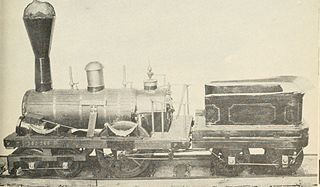
Sandusky was the name of a steam railroad locomotive, a 4-2-0, built in the United States. This locomotive included engineering features that hadn't been used before in locomotive construction and it played an integral role in the railroad history of Ohio.
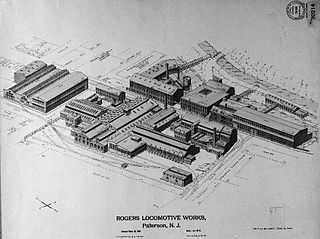
Rogers Locomotive and Machine Works was a manufacturer of railroad steam locomotives based in Paterson, in Passaic County, New Jersey, in the United States. Between its founding in 1832 and its acquisition in 1905, the company built more than 6,000 steam locomotives for railroads around the world. Most 19th-century U.S. railroads owned at least one Rogers-built locomotive. The company's most famous product was a locomotive named The General, built in December 1855, which was one of the principals of the Great Locomotive Chase of the American Civil War.
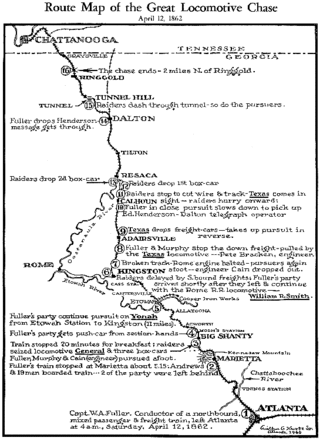
The Western & Atlantic Railroad of the State of Georgia (W&A) is a railroad owned by the State of Georgia and currently leased by CSX, which CSX operates in the Southeastern United States from Atlanta, Georgia, to Chattanooga, Tennessee.

The Great Locomotive Chase was a military raid that occurred April 12, 1862, in northern Georgia during the American Civil War. Volunteers from the Union Army, led by civilian scout James J. Andrews, commandeered a train, The General, and took it northward toward Chattanooga, Tennessee, doing as much damage as possible to the vital Western and Atlantic Railroad (W&A) line from Atlanta to Chattanooga as they went. They were pursued by Confederate forces at first on foot, and later on a succession of locomotives, including The Texas, for 87 miles (140 km).
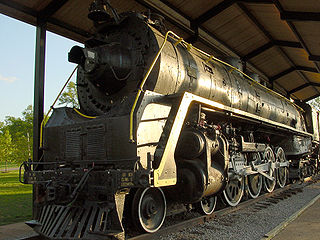
The Nashville, Chattanooga and St. Louis Railway was a railway company that operated in the U.S. states of Kentucky, Tennessee, Alabama, and Georgia. It began as the Nashville and Chattanooga Railroad, chartered in Nashville on December 11, 1845, built to 5 ft gauge and was the first railway to operate in the state of Tennessee. By the turn of the twentieth century, the NC&StL grew into one of the most important railway systems in the southern United States.

The Louisville and Nashville Railroad, commonly called the L&N, was a Class I railroad that operated freight and passenger services in the southeast United States.
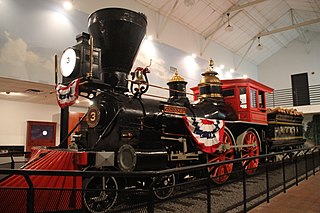
Western & Atlantic Railroad #3 General is a 4-4-0 "American" type steam locomotive built in 1855 by the Rogers, Ketchum & Grosvenor in Paterson, New Jersey for the Western & Atlantic Railroad, best known as the engine stolen by Union spies in the Great Locomotive Chase, an attempt to cripple the Confederate rail network during the American Civil War. Today, the locomotive is preserved at the Southern Museum of Civil War and Locomotive History in Kennesaw, Georgia, and is listed on the National Register of Historic Places.

The Central of Georgia Railway started as the Central Rail Road and Canal Company in 1833. As a way to better attract investment capital, the railroad changed its name to Central Rail Road and Banking Company of Georgia. This railroad was constructed to join the Macon and Western Railroad at Macon, Georgia, in the United States, and run to Savannah. This created a rail link from Chattanooga, on the Tennessee River, to seaports on the Atlantic Ocean. It took from 1837 to 1843 to build the railroad from Savannah to the eastern bank of the Ocmulgee River at Macon; a bridge into the city was not built until 1851.

James J. Andrews was a Kentucky civilian who worked for the Union Army during the early years of the American Civil War. He led a daring raid behind enemy lines on the Western and Atlantic Railroad, known as the Great Locomotive Chase. Andrews and seven fellow raiders were caught at the end of the chase and executed by the Confederates on the charge of spying.

The Great Locomotive Chase is a 1956 American adventure western film produced by Walt Disney Productions, based on the Great Locomotive Chase that occurred in 1862 during the American Civil War. Filmed in CinemaScope and in color, the film stars Fess Parker as James J. Andrews, the leader of a group of Union soldiers from various Ohio regiments who volunteered to go behind Confederate lines in civilian clothes, steal a Confederate train north of Atlanta, and drive it back to Union lines in Tennessee, tearing up railroad tracks and destroying bridges and telegraph lines along the way.

William Allen Fuller was a conductor on the Western & Atlantic Railroad during the American Civil War era. He was most noted for his role in the 1862 Great Locomotive Chase, a daring sabotage mission and raid conducted by soldiers of the Union Army in northern Georgia. Fuller's determined pursuit prevented the Union agents from driving a captured train north to Tennessee and the Union lines.

Western & Atlantic Railroad #49 "Texas" is a 4-4-0 "American" type steam locomotive built in 1856 for the Western & Atlantic Railroad by Danforth, Cooke & Co., best known as the principal pursuit engine in the Great Locomotive Chase, chasing the General after the latter was stolen by Union saboteurs in an attempt to ruin the Confederate rail system during the American Civil War. The locomotive is preserved at the Atlanta History Center.
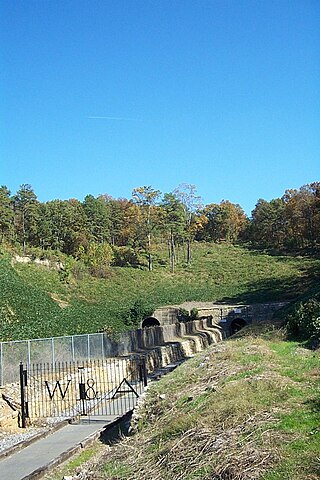
The Chetoogeta Mountain Tunnel refers to two different railroad tunnels passing through Chetoogeta Mountain in Tunnel Hill, Georgia, United States.

William Hunter Campbell was an Ohio civilian who worked for the Union Army during the early years of the American Civil War. He participated in a daring raid behind enemy lines on the Western and Atlantic Railroad, known famously as the Great Locomotive Chase. The mission failed and Campbell and seven fellow raiders were executed by the Confederates on the charge of spying.

Wilson Wright Brown was a soldier and recipient of the Medal of Honor for his role in the Great Locomotive Chase during the American Civil War.

William Bensinger was an American soldier who fought for the Union in the American Civil War. On March 25, 1863, he was the second person given the country's highest award for bravery during combat, the Medal of Honor, for his actions during the Great Locomotive Chase in Georgia in April 1862.

Robert Buffum was an American soldier who fought in the American Civil War. Buffum was the third person to receive the country's highest award for bravery during combat, the Medal of Honor, for his action during the Great Locomotive Chase in Georgia in April 1862. He was honored with the award on 25 March 1863.
Chattanooga Union Station, more commonly known as the Union Depot in Chattanooga, constructed between 1857 and 1859, served as a train car shed in Chattanooga, Tennessee. Located at Broad and Ninth Streets, the station was one of two major railroad terminals in the city, the other being the Southern Railway's Terminal Station.
{{cite web}}: CS1 maint: multiple names: authors list (link)